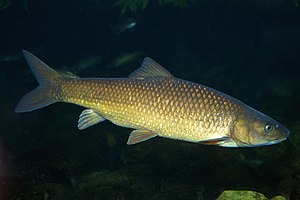Labeobarbus seeberi
| Labeobarbus seeberi | ||||||||||||
|---|---|---|---|---|---|---|---|---|---|---|---|---|

Labeobarbus seeberi |
||||||||||||
| Systematics | ||||||||||||
|
||||||||||||
| Scientific name | ||||||||||||
| Labeobarbus seeberi | ||||||||||||
| ( Gilchrist & Thompson, 1913) |
Labeobarbus seeberi ,called Clanwilliam yellowfish after the city of Clanwilliam , is a large carp fish species that is endemic only to South Africa .
description
Labeobarbus seeberi is very similar in physique to the European barbel . He has barbels and has a dark brown color on the back, which turns into a copper-brown on the flanks, the fins are often reddish in color. The silvery juvenile fish often have a stripe-like pattern on the sides, which only turns into light brown in the adult stage. The sexually mature males have a strong golden brown color at spawning time. Like almost all species of the genus Labeobarbus , Labeobarbus seeberi is also large. Specimens weighing 5 kilograms and 60 centimeters in length, as well as 10 kilograms weighing almost one meter in length, were caught in the Olifants River.
Occurrence and habitat
Labeobarbus seeberi is only endemic to South Africa . Its distribution area is limited to the Western Cape in the river system of the Olifants River and its tributaries Doring River, Biedou, Boskloof, Driehoeks, Groot, Jan Dissels, Kobee, Noordhoeks, Ratels, Rondegat, Thee and the lower Twee Rivers in the Cederberg Mountains .
Above the Clanwilliam Dam and in the Olifants Gorge, where it was previously very numerous, it is almost extinct.
It occurs in deep pools of the main stream as well as in large tributaries and barrages. Slowly flowing water is usually avoided. Young fish up to four centimeters in size like to stay in backed up water and shallow rapids. With increasing size, they then predominantly live in deeper water. As the rivers often periodically dry out, deep pools and dense populations of palm reeds ( Prionium serratum ) are important for the survival of Labeobarbus seeberi during the hot dry periods.
Way of life
Labeobarbus seeberi is omnivorous and has a wide range of foods from algae and invertebrates to insects , snails and crustaceans . Larger adult fish also feed on frogs and smaller prey fish. In summer Labeobarbus seeberi begins its spawning migration upstream and spawns in small groups over gravel beds in shallow water. In dams, Labeobarbus seeberi looks for flat spots with large stones. The spawning season lasts from late spring to summer in the months of October to December with a water temperature of at least 20 ° C.
Systematics
The scientific name Labeobarbus capensis ( Smith, 1841 ) was assigned to the Clanwilliam yellowfish for a long time . However, a new investigation of the holotype of Labeobarbus capensis showed that it cannot be placed in the genus Labeobarbus and instead belongs to the same species as the type specimens of Pseudobarbus andrewi ( Barnard, 1937 ). This species occurs in the Breede River south of the Olifants River. Labeobarbus capensis is therefore a senior synonym of Pseudobarbus andrewi and Pseudobarbus capensis is the valid name for this species according to the priority rule of biological nomenclature . The new scientific name for the Clanwilliam yellowfish is the name Labeobarbus seeberi (Gilchrist & Thompson, 1913) , previously a junior synonym of Labeobarbus capensis .
Use
Labeobarbus seeberi is kept experimentally in aquacultures and is of certain importance as a sport fish.
Hazardous situation
The population of Labeobarbus seeberi declined dramatically between 1940 and 1970 when the American black bass ( Micropterus dolomieu ) was introduced to South Africa. Since black bass specialized in the breeding of Labeobarbus seeberi , the fish species came to the brink of extinction. Other predatory fish that strongly decimate Labeobarbus seeberi are the largemouth bass ( M. salmoides ), the spotted perch ( M. punctalatus ) and the blue sunfish ( Lepomis macrochirus ). Cichlids like Tilapia sparrmanii can compete with food.
Additional threats are habitat destruction from dam construction (Clanwilliam and Bulshoek dams), river bed canalization, water pollution, and the introduction of biocides and fertilizers from agricultural production. This destroyed about 90% of the natural habitat of Labeobarbus seeberi . The species is marked as critically endangered on the IUCN Red List . The Western Cape Province Nature Conservation Ordinance has issued an absolute ban on killing this species. Catches are only permitted for scientific purposes or for monitored relocation to another body of water. In the 1990s, a government-sponsored breeding program began to preserve this species. In 1980, juvenile fish were introduced into the Twee River between two waterfalls that they could not pass. Here it entered into food competition with the rare Pseudobarbus erubescens , another endangered species of fish. In 1997 the National Yellowfish Working Group was founded, which deals with research as well as public relations work for the conservation of Labeobarbus seeberi . In 1999, the eradication of invasive fish species began in the Krom and Rondegat Rivers in order to preserve the endemic fish population in the Cederberg Wilderness Area.
Notes and individual references
- ↑ a b c d e Labeobarbus capensis on Fishbase.org (English)
- ↑ a b c d e f g https://apiv3.iucnredlist.org/api/v3/taxonredirect/63290
- ↑ Emmanuel JWMN Vreven, Tobias Musschoot, Jos Snoeks & Ulrich K. Schliewen: The African hexaploid Torini (Cypriniformes: Cyprinidae): review of a tumultuous history. Zoological Journal of the Linnean Society, Jan. 2016, DOI: 10.1111 / zoj.12366 , page 21
- ↑ act as barriers during spawning ascent